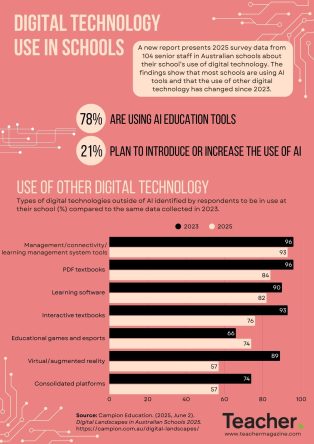Last term, Teacher columnist Professor Martin Westwell – Chief Executive of the South Australian Department for Education – wrote about the implementation of a custom generative AI tool, EdChat, in government schools across South Australia. In this article, we speak with Sarah Chambers, principal at Adelaide Botanic High School – one of the first adopters of the tool back in 2023 – about how students and staff are using the tool.
At Adelaide Botanic High School, both staff and students have been using EdChat, a generative AI tool developed by the South Australia Department for Education for use by schools, since the trial period began in 2023. ‘Tomorrow, today’ is the motto at the vertical school that opened in 2019 and is home to 1,300 students across years 7-12.
‘I don't think it was it probably even conceived of that we wouldn't be part of a trial of something like EdChat, because we know that our educators come here to work in a space where they get to push those boundaries, to be on the edge of the new learning at all times, to be at the forefront of what good practice looks like,’ Principal Sarah Chambers tells Teacher.
‘We have an environment that absolutely is invested in exploring what this might look like for educators and students and young people now and into the future. And I think AI is one of those significant impacts of change in our current experience – if we look at, sort of between 2023 and now, the change in the landscape around AI is quite radical.’
A secure tool to support teaching and learning
A roadblock for schools using other generative AI tools available to the public, such as ChatGPT, is that the environment is not secure. EdChat was launched by the Department for Education with guardrails to ensure safe and ethical use, so staff and students can explore the tool freely.
‘[EdChat] has the data security … that just means that we can guarantee our students are not going to encounter content that's not appropriate; that any data that they share within that is not put back into the broader system. It's just kept within that secure environment, which is so good in a school context,’ Chambers explains.
‘I think that's the greatest difference for me as a leader within a school; that I know, when using EdChat, that our students do have that data security and the content security as well.’
How students are embracing AI
Students at the school have been using EdChat in a range of ways. For example, Chambers shares one student uses EdChat as a study planner to help with time management, and others use it to generate revision questions by feeding EdChat material from their teacher and prompting the tool to ask them progressively more challenging questions.
In the term 2 holidays, Chambers travelled to Osaka, Japan, with staff and students to present at the World Expo 2025 on their use of EdChat. Students created videos for their student-led presentation sharing examples of how they’re using the generative AI tool.
‘A couple of our students told the story of using EdChat to help them learn how to code or how to use applications like Premiere Pro to edit film and, rather than watching tutorials online where they had to watch a whole section to find the tiny bit that they wanted, they could ask the questions around: “I want to do this. How do I do this? How do I make that happen?” And it could be far more targeted as that guide on the side.’
EdChat is supporting teachers to save time
Chambers says staff are learning about EdChat alongside students, and many have found ways to reduce their workload.
One such example has seen a common task for teachers that typically takes 30 minutes, reduce to 52 seconds (Department for Education, 2025) with the help of EdChat. Adelaide Botanic High School teacher Rebecca Weber identified an opportunity for EdChat to assist in assessing a student’s LEAP (Learning English: Achievement and Proficiency) Level.
The Department (2025) says this process involves a teacher assessing a text that has been written by a student, and in 2024, 31,434 students were assessed across the state, with each writing sample taking an average of 30 minutes to be processed by a teacher. With EdChat completing this process in less than a minute, they say teachers will save thousands of hours of work.
Chambers adds that EdChat is helping other staff at the school support students with a language background other than English. Another staff member has created an app to benefit careers counselling activities. The app collates university and TAFE information that would otherwise be contained in hardback guidebooks and need to be manually referred to.
‘And so she uses that as, again, a guide on the side that she can – when career counselling with students and looking at subject selections for their year 11 and 12 – the conversation she has moves from the what to the why and that really strong connection with the young person … because the information she needs is at hand,’ Chambers says.
Keeping humans at the centre
According to Chambers, an important driver around the school’s use of EdChat is keeping humans at the centre.
‘Some of the writing about AI talks about having a human in the loop, but actually, we like to say that we've got the AI in the loop and that the humans are still at the centre,’ she says.
‘It's another tool that becomes one of those things that our students need to have the confidence to use, but we also need to make sure that they've got the skills and the attributes and the human skills that they need to be able to navigate what is appropriate, what isn't.’
References
Department for Education South Australia (2025, June 4). AI tool saves teachers thousands of hours. https://www.education.sa.gov.au/department/media-centre/our-news/ai-tool-saves-teachers-thousands-of-hours-of-work
As a teacher, how are you navigating keeping humans at the centre when working with AI? What does this actually look like in practice? Can you think of a specific example of how you’ve done this in your own classroom?
As a school leader, does your school have guidelines about the use of AI tools? How are you ensuring the tools are being used ethically and safely? Have you considered both data security and content security when using these tools?



